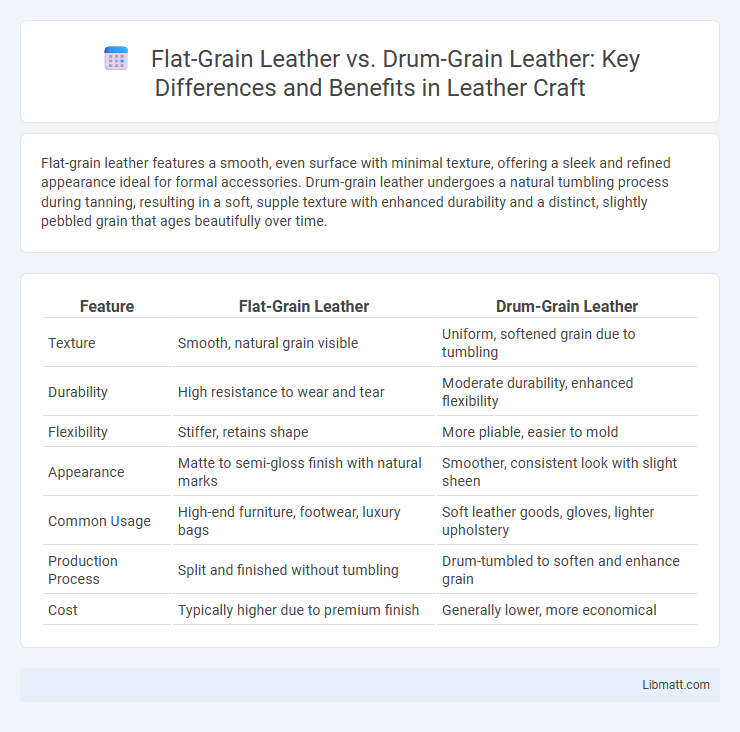Flat-grain leather features a smooth, even surface with minimal texture, offering a sleek and refined appearance ideal for formal accessories. Drum-grain leather undergoes a natural tumbling process during tanning, resulting in a soft, supple texture with enhanced durability and a distinct, slightly pebbled grain that ages beautifully over time.
Table of Comparison
| Feature | Flat-Grain Leather | Drum-Grain Leather |
|---|---|---|
| Texture | Smooth, natural grain visible | Uniform, softened grain due to tumbling |
| Durability | High resistance to wear and tear | Moderate durability, enhanced flexibility |
| Flexibility | Stiffer, retains shape | More pliable, easier to mold |
| Appearance | Matte to semi-gloss finish with natural marks | Smoother, consistent look with slight sheen |
| Common Usage | High-end furniture, footwear, luxury bags | Soft leather goods, gloves, lighter upholstery |
| Production Process | Split and finished without tumbling | Drum-tumbled to soften and enhance grain |
| Cost | Typically higher due to premium finish | Generally lower, more economical |
Introduction to Leather Graining Techniques
Flat-grain leather features a smooth, uniform surface with minimal texture, achieved by carefully sanding and finishing the hide, while drum-grain leather is created through a natural tumbling process in a drum, resulting in a rich, textured grain full of character. These leather graining techniques influence the durability, appearance, and flexibility of the material, with drum-grain leather often prized for its robust and natural look. Understanding the differences between flat-grain and drum-grain leather allows you to select the best option for your leather goods based on desired aesthetics and performance.
What is Flat-Grain Leather?
Flat-grain leather, also known as corrected grain leather, is produced by sanding and buffing the surface to remove imperfections, resulting in a smooth, uniform texture. This type of leather often undergoes stamping or embossing to create a consistent grain pattern, enhancing its durability and resistance to wear. It is commonly used in furniture and accessories where a polished appearance and toughness are essential.
What is Drum-Grain Leather?
Drum-grain leather refers to hide that has been tumbled in a rotating drum to soften the texture and produce a natural, pebbled grain pattern. This process enhances the leather's durability and flexibility while maintaining a rugged appearance ideal for everyday use. If you're seeking leather with a textured, resilient finish, drum-grain leather offers superior strength compared to flat-grain options.
Visual Differences: Flat-Grain vs Drum-Grain
Flat-grain leather displays a smooth, tight surface with minimal texture, offering a sleek and uniform visual appeal, while drum-grain leather features a pronounced, pebbled texture created by tumbling in a drum during the finishing process. This process enhances the natural grain patterns, resulting in a more rugged and textured appearance that often reveals distinctive creases and wrinkles. Your choice between flat-grain and drum-grain leather will impact the aesthetic of leather goods, balancing elegance versus a robust, tactile look.
Texture and Feel Comparison
Flat-grain leather features a smooth, even surface with minimal texture, providing a soft and supple feel ideal for refined accessories and upholstery. Drum-grain leather undergoes a tumbling process that creates a more pronounced, pebbled texture, resulting in a thicker, more durable material with enhanced grip and a rugged aesthetic. The contrast in texture directly impacts the tactile experience, with flat-grain leather offering sleekness and drum-grain leather delivering a tactile, textured feel.
Durability and Longevity
Flat-grain leather, with its tight, smooth surface, offers moderate durability but is more prone to scratches and visible wear over time compared to drum-grain leather. Drum-grain leather undergoes a tumbling process that enhances its natural grain texture, resulting in increased resistance to scuffs and a longer lifespan. This makes drum-grain leather a preferred choice for products requiring superior durability and extended longevity, such as high-end shoes and luxury bags.
Common Uses for Flat-Grain Leather
Flat-grain leather is commonly used for high-quality footwear, upholstery, and fashion accessories due to its smooth texture and durable surface. Its fine grain structure provides a refined, polished finish ideal for luxury shoes and handbags. Compared to drum-grain leather, flat-grain leather maintains a more consistent appearance, making it preferred in applications requiring elegance and longevity.
Common Uses for Drum-Grain Leather
Drum-grain leather is commonly used in high-end upholstery, luxury handbags, and premium footwear due to its tightly packed, natural grain that enhances durability and texture. This type of leather is favored in automotive interiors and bespoke furniture for its rich appearance and resistance to wear. Its unique grain pattern makes it ideal for crafting artisan wallets and watch straps that require a balance of strength and aesthetic appeal.
Care and Maintenance Tips
Flat-grain leather requires regular conditioning with a pH-balanced leather conditioner to maintain its smooth texture and prevent cracking, while avoiding excessive moisture exposure to preserve its surface integrity. Drum-grain leather benefits from periodic cleaning with a damp cloth and specialized leather cleaner to maintain its natural grain pattern and softness, followed by moisturizing treatments to sustain suppleness. Both types should be kept away from direct sunlight and heat sources to prevent fading and drying out, extending the lifespan of the leather.
Which Leather Grain is Right for You?
Flat-grain leather offers a smooth, uniform surface that highlights a sleek and elegant appearance, ideal for those seeking refined aesthetics and easy maintenance. Drum-grain leather features a textured, natural grain pattern created through traditional drum-dying processes, providing enhanced durability and a vintage look suitable for rugged or rustic styles. Choosing between flat-grain and drum-grain leather depends on your preference for either a polished finish or a resilient, character-rich material.
Flat-grain leather vs drum-grain leather Infographic

 libmatt.com
libmatt.com